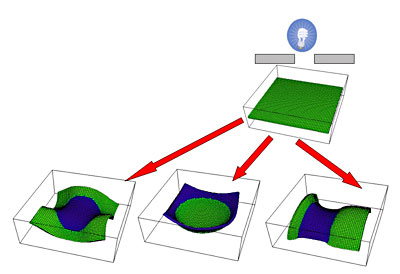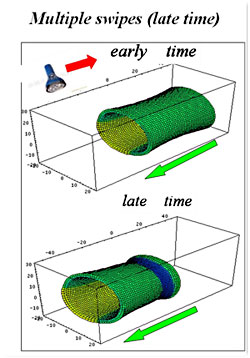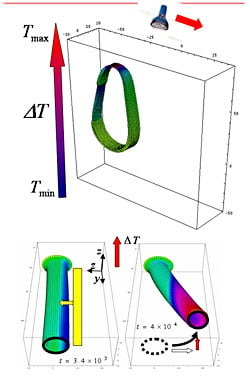PITTSBURGH, Aug. 5, 2013 — Researchers at the University of Pittsburgh used light to reconfigure hydrogels and induce self-sustained motion. This biomimetic behavior in a non-living organism could have significance for a host of applications in the medical arena, including microfluidics and optics.
 The team demonstrated that the gels “ran away” when exposed to the
light, exhibiting direct, sustained motion. The team also factored in
heat — combining the light and local variations in temperature to
further control the motions of the samples. Controlling a material with
light and temperature could be applicable, Balazs said, in terms of
regulating the movement of a microscopic “conveyor belt” or “elevator”
in a microfluidic device.
The team demonstrated that the gels “ran away” when exposed to the
light, exhibiting direct, sustained motion. The team also factored in
heat — combining the light and local variations in temperature to
further control the motions of the samples. Controlling a material with
light and temperature could be applicable, Balazs said, in terms of
regulating the movement of a microscopic “conveyor belt” or “elevator”
in a microfluidic device.

Photo-morphing of initially flat gel sample into various shapes by illumination. Images Courtesy University of Pittsburgh.
“Consider, for example, that you could take one sheet of hydrogel and,
with the appropriate use of light, fashion it into a lens-shaped object,
which could be used in optical applications,” she added.

Using the light to move the gel.
The team also demonstrated that the gels could undergo dynamic reconfiguration — that is, with different combinations of light, the same gel can be reused for different purposes.
“You don’t need to construct a new device for every new application,” Balazs said. “By swiping light over the system in different directions, you can further control the movements of a system, further regulating the flow of materials.”

Using temperature gradient to further control the motion.
The team will now study the effect of embedding microscopic fibers into the gel to further control the shape and response of the material to other stimuli.
The article appears online in Advanced Functional Materials (doi: 10.1002/adfm.201203876).
For more information, visit: www.news.pitt.edu